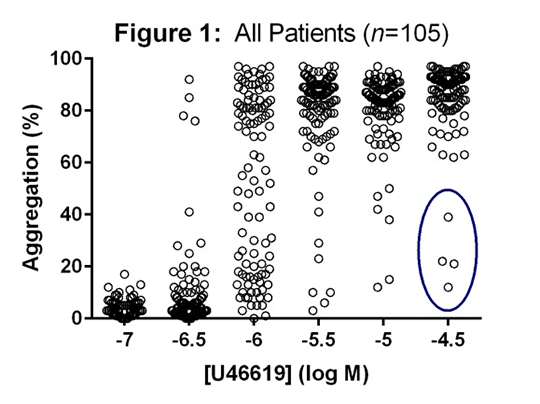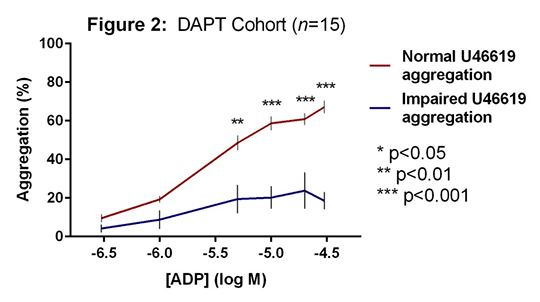Utility of Platelet Agonist U46619 to Guide Personalised Antiplatelet Therapy Introduction: Dual antiplatelet therapy (DAPT) leads to adverse bleeding events, which are both intrinsic to platelet inhibition and secondary to aspirin’s inhibition of gastric prostanoids. It has been demonstrated in vitro that in the presence of complete P2Y12 receptor blockade, aspirin provides little additional inhibition of platelet aggregation [1]. A cohort of patients on DAPT may therefore be exposed to an increase risk of major bleeding, especially gastrointestinal bleeding, unnecessarily. Activation of the thromboxane (TP) receptor is required for platelet cyclooxygenase-1 (COX-1) mediated aggregation, and TP receptor activity has been previously shown to be inhibited in vitro and in vivo by P2Y12 antagonists. Platelet function testing using the TP receptor agonist U46619 may therefore be able to guide personalisation of antiplatelet therapy. Methods: Whole blood was drawn into citrate (final concentration 0.32%) from patients with stable coronary artery disease receiving antiplatelet therapy (n=90 aspirin 75mg daily; n=15 aspirin plus P2Y12 antagonist). Platelet function was assessed in platelet-rich plasma (PRP) by Optimul in response to adenosine diphosphate (ADP; 0.3-30µM) and U46619 (0.1-30μM) [2]. Aspirin response was assessed by 1.6mM AA-induced light transmission aggregometry (LTA) and subsequent thromboxane B2 levels in plasma supernatant (EIA kit; Cayman Chemical). Impaired aggregation in response to 30μM U46619 was defined as mean-2SD. Statistical analyses were performed using Fisher’s exact test and Mann-Whitney test, with significance at p<0.05. Results: Four patients demonstrated impaired U46619-induced aggregation at 30μM, all of whom were prescribed DAPT (p<0.001; Figure 1: circled). All DAPT patients demonstrated normal functional and biochemical responses to aspirin therapy. Patients on DAPT with impaired U46619-induced aggregation demonstrated reduced aggregation in response to 5-30μM ADP when compared to those with normal U46619-induced aggregation (p<0.010; Figure 2). Conclusions: U46619-induced platelet aggregation can identify patients on DAPT who due to good levels of P2Y12 receptor blockade are unlikely to gain additional platelet inhibition from aspirin therapy. Personalisation of antiplatelet therapy based on TP receptor response may facilitate aspirin cessation in some patients, thus reducing risk of gastric bleeding without increasing cardiovascular risk.
(1) Armstrong PC et al. (2011) J Thromb Haemost 9:552-61 (2) Chan MV, Warner TD. (2012) Platelets 23: 404-8
|



